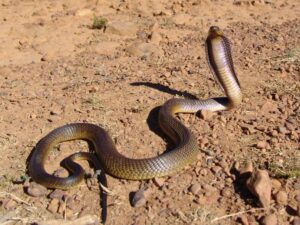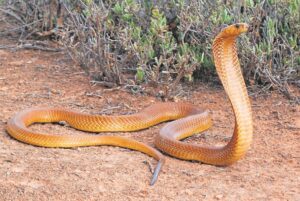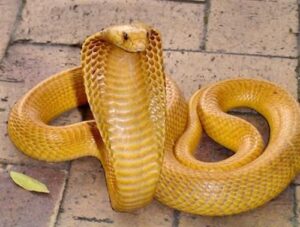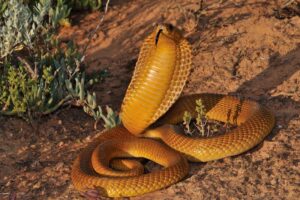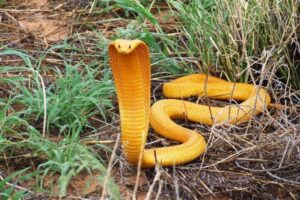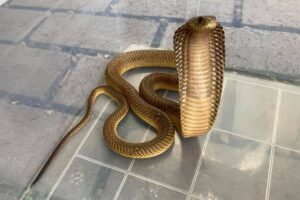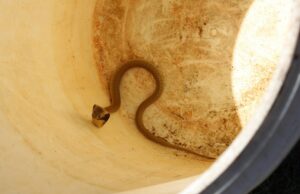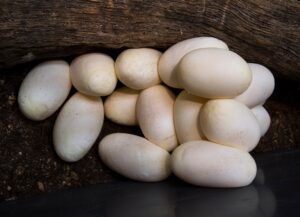The cape cobra, or the yellow cobra, is a venomous snake with limited distribution in southern Africa. It is one of the four southern African non-spitting cobras besides the Anchieta’s cobra, forest cobra, and snouted cobra. This species was first described in 1758 by the Swedish zoologist Carl Linnaeus. Its genus name ‘naja‘ derives from the Sanskrit word nāgá meaning “snake”. And the species epithet, ‘nivea‘, derives from the Latin words nix or nivis, which means “snow”, or the term niveus meaning “snowy”.
Among the four subgenres in the genus ‘Naja‘, the cape cobra is placed under ‘Uraeus‘. In South Africa, they are known as “geelslang”, meaning yellow snake, and “bruinkapel”, meaning brown cobra. The Afrikaans speakers call it “koperkapel”, which means copper cobra. They get these names due to the color variation.
Scientific Classifications
- Suborder:Serpentes
- Family:Elapidae
- Genus:Naja
- Species:N. nivea
Conservation Status
Description
Size
The average length of the cape cobra is up to 3.9-5.2 ft (1.2 m to 1.6 m). Of the two longest specimens recorded, one was from the village of Aus in the Karas region of Namibia, measuring 6.2 ft (1.88 m), and the other measuring 6.1 ft (1.86 m) was from De Hoop Nature Reserve. Both individuals were male.
Color and Appearance
Their body coloration varies from black to dark brown to golden brown and yellow, with black or pale spots and blotches that may or may not be on every specimen. They have broad heads and rounded cheeks, and the end of their tail is often darker than the rest of their bodies. Juveniles have dark bands on their throats, which often get them confused with rinkhals.
Their color variation depends on their location. For instance, snakes of the Botswanian and Namibian Kalahari Desert region tend to have a more consistent yellow coloration than those that live more to the south. Despite these variations, specimens of different appearances can be spotted in one place. One such place is De Hoop Nature Reserve.
Are they Dangerous
It is considered one of Africa’s most dangerous cobra species. Their venom has an LD50 value of 0.6 mg/kg and a 100-250 mg yield per bite. Like most snake species, the cape cobra also tends to avoid humans. Upon encountering them, they prefer running away instead of attacking.
Even though they cannot spit venom, their bite can be potent; it injects fast-acting venom containing cardiotoxins and postsynaptic neurotoxins that paralyze the heart, the nervous, and respiratory systems. If bitten by a cape cobra, medical help should be sought immediately since there is a chance of death occurring within 1-10 hours.
In spite of their timid nature, these cobras make up the majority of snake bites compared to other African snakes. As they hunt and live in different populated areas and sometimes enter houses to escape the heat during the day, cape cobras encounter many humans, so the chances of them getting bitten are high, making them dangerous in their range.
Cape Cobra At a Glance
Distribution
The geographical range of these snakes extends across the provinces of the Eastern Cape, Free State, Northern Cape, North West Province, and Western Cape. They also live in southwestern Botswana, western Lethoso, and southern Namibia. This cobra has a smaller distribution than all the cobras in Africa.
Habitat
Cape cobras prefer deserts, grasslands, and scrublands. They inhabit the Bushveld, Fynbos, dry sandy areas of the Karoo, Kalahari, and Namib deserts, and other forms of shrubland. In their arid karroid and temperate habitats, they dwell by the rivers as well as other areas with water and are found at an elevation of 8,200 ft (2,500 m) from the sea level in Lethoso. Also, they may shelter in abandoned termite mounds, rock crevices, and rodent burrows.
Sometimes, these snakes enter human settlements like villages, squatter communities, and suburban regions with abundant rodents.
Lifespan
In captivity, they survive for 12-20 years, but their lifespan in the wild is unknown since it’s difficult to determine.
Predators
Birds of prey, such as secretary birds and snake eagles, prey on these cobras, as do honey badgers, meerkats, and different mongoose species. Other snakes also prey on them.
Despite being non-aggressive creatures, while in defense, they take on a threatening position, rising up, spreading their hoods by expanding the flexible ribs in their necks, and striking readily without hesitation. Although, if they only hiss with their hoods spread, it is not considered aggressive behavior; instead, it’s a warning to keep potential threats away. These snakes try to escape if the attacker stays still. But they reassume their defensive posture if they notice any movement.
Diet
They are generalist feeders with a primary diet consisting of birds and rodents. Apart from that, they also consume carrion, frogs, lizards, and other snakes, including individuals of their own species.
Cape cobras are diurnal, mostly hunting during the day. Despite being mainly terrestrial, they can easily climb trees and readily do so in search of food. For example, these cobras raid sociable weaver’s nests to steal their eggs or hunt young birds.
When the temperature rises, they turn more crepuscular, hunting during dusk and dawn. However, they are rarely seen after dark.
Reproduction
The breeding season occurs in September and October, when they show more aggressive behavior than usual. Although generally solitary, these snakes come together during this time.
Being oviparous, females lay 8-20 eggs, each measuring 2.3 inches long and 0.98 inches wide, in abandoned termite mounds, holes, or other warm locations. The emerging hatchlings are 13-16 inches long and are independent from birth.
One of the captive studies recorded the gestation period to last for approximately 42 days, and it takes about 65-70 days to incubate the eggs. However, the information about this process in the wild remains unknown.
Similar Species
Rinkhals
Rinkhalses are often confused with juvenile cape cobras. However, unlike the cape cobra, rinkhals is not a ‘true cobra’ since it is placed under a different genus than ‘naja‘.
Mole Snakes
Although somewhat similar, the mole snake and the cape cobra are easily distinguishable. Cape cobras have broad heads with chunky cheeks, while mole snakes have small heads elongated with pointed snouts. Also, the cape cobras are incredibly venomous. At the same time, the mole snakes are non-venomous, although they can inflict a powerful bite.
Source
alchetron.com, africansnakebiteinstitute.com, i.pinimg.com, static.wikia.nocookie.net, citizen.co.za, pbs.twimg.com, fbcdn.net

